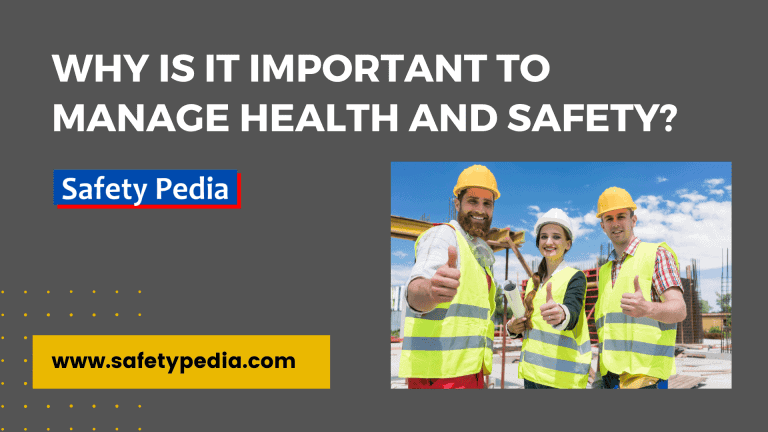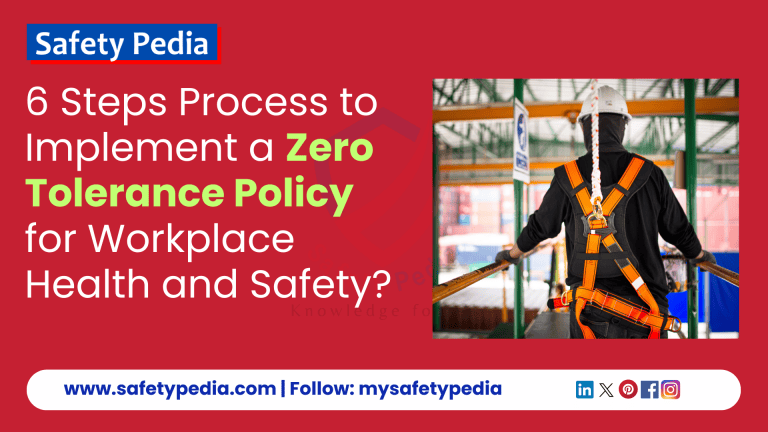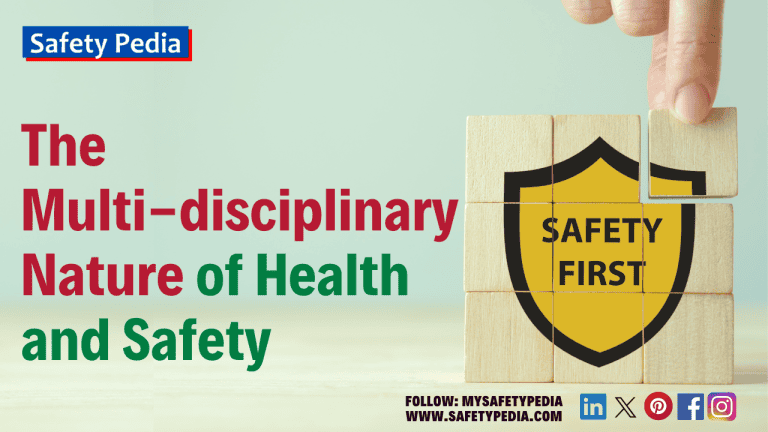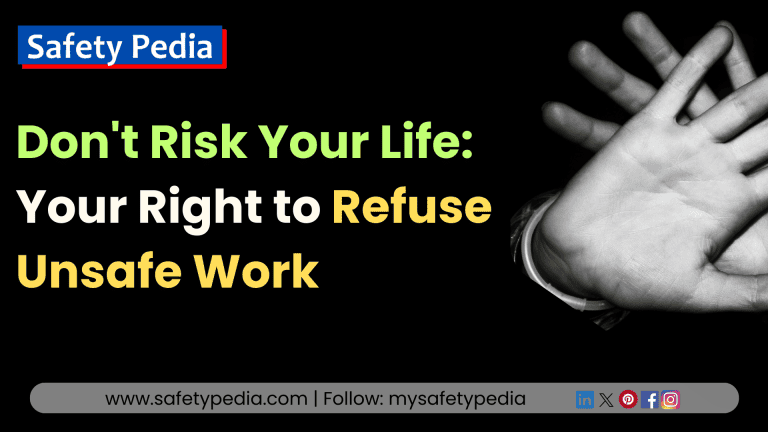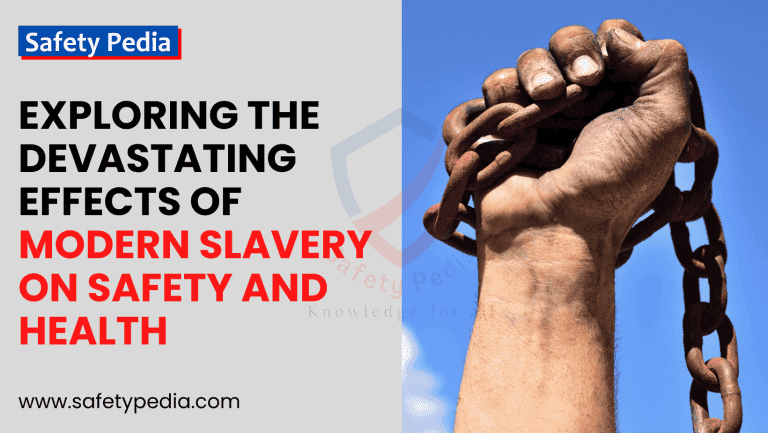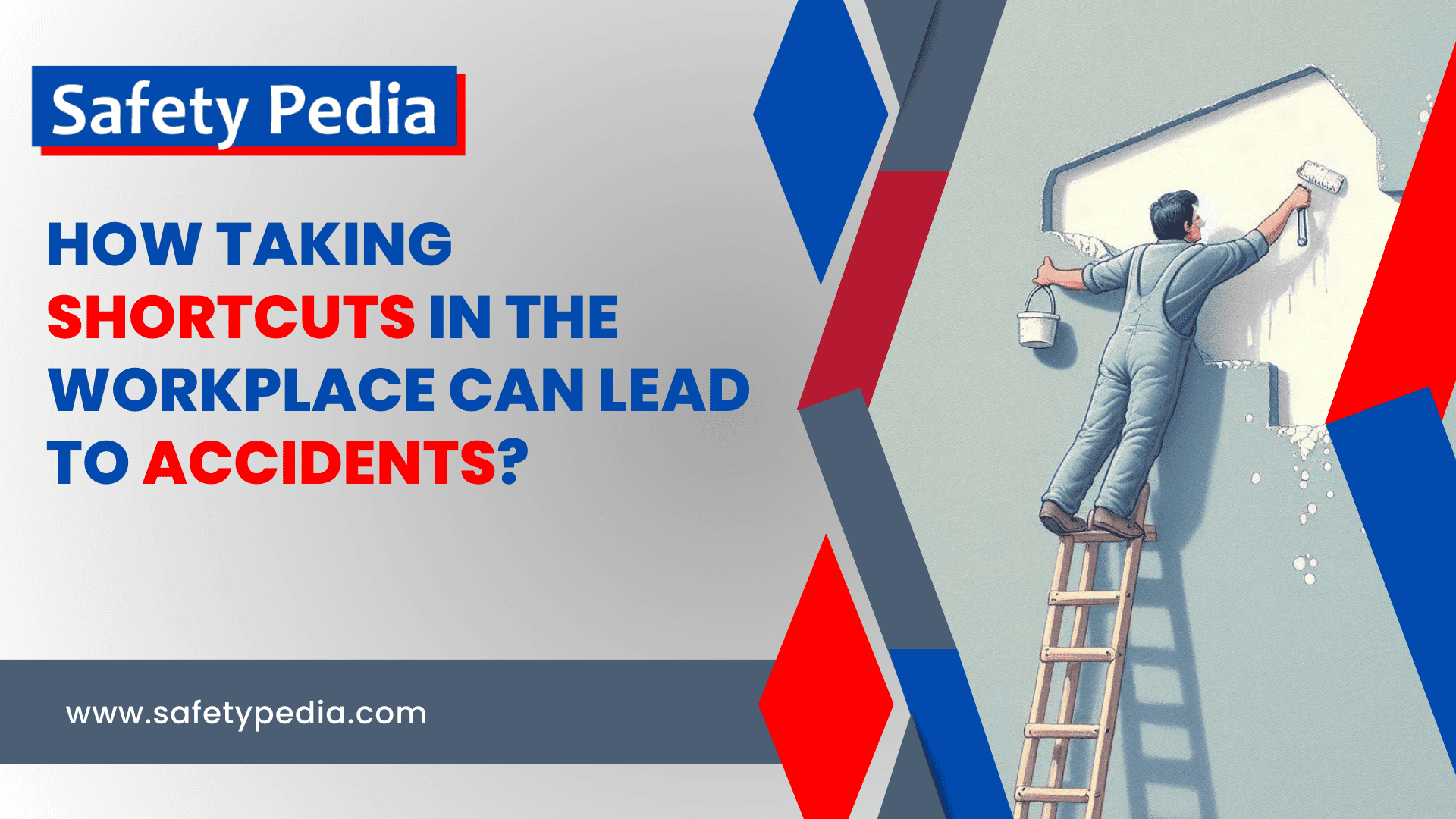
Introduction: Taking Shortcuts in the Workplace
In the workplace, cutting corners might seem like an easy way to save time and energy. But it can lead to accidents and injuries. Taking shortcuts in the workplace with safety is never safe. It puts the individual plus their colleagues at risk. Everyone wants to complete the job quickly. At the same time, taking shortcuts poses a great risk of injury. This article will explain why shortcuts should be avoided in the workplace and the possible consequences.
Safety measures are in place to guard workers and create a secure workplace. But when these are skipped, people and their peers are exposed to needless dangers.
Pressure or convenience may lead people to take shortcuts. Employees could be forced to do tasks rapidly and break safety rules. Some may think shortcuts are harmless or small, but they can involve risks.
.jpg)
A true history shows the significance of avoiding shortcuts at work. At a manufacturing company, an employee ignored a safety lockout procedure on equipment – and had a serious accident with severe injuries. This impacted the injured worker and their coworkers who saw it.
What is a shortcut in the workplace?
A shortcut in the workplace is a way to do a task or complete a project quickly and easily. This often means bypassing safety measures. It might seem efficient, but it can be dangerous. It’s important to never take shortcuts with safety.
Taking shortcuts in the workplace can be very risky. Skipping safety inspections, not wearing PPE, and rushing through tasks without proper training or supervision can put workers in danger. It’s not worth risking your well-being for a shortcut. Employees should follow established procedures and guidelines to reduce the chances of an accident occurring.
Employers must also take steps to ensure safety. They should provide training, hold safety meetings, and enforce protocols.
An example of the dangers of taking shortcuts is the construction site accident. A worker tried to climb a ladder without securing it properly. The ladder slipped, and he fell and was seriously injured. This shows that even small shortcuts can have serious consequences.
Shortcuts vs safety measures
“Shortcuts vs safety measures” refers to the dilemma faced in the workplace when employees are tempted to take shortcuts to save time or effort, but doing so may compromise safety. Shortcuts and safety measures are two opposing concepts. Shortcuts are ways to do things quickly and easily, often by skipping steps or ignoring safety procedures. Safety measures, on the other hand, are things we do to protect ourselves and others from harm.
In the workplace, shortcuts can be dangerous. When you take a shortcut, you often increase the risk of an accident or injury. For example, if you don’t wear the proper personal protective equipment (PPE) because it’s too uncomfortable or time-consuming, you are putting yourself at risk of injury. Or, if you rush a task and don’t follow all of the safety procedures, you could make a mistake that could lead to an accident.
On the other hand, safety measures help reduce the risk of accidents and injuries. Therefore, it is important to follow the best practices and standards and always adhere to the safety measures. Shortcuts may seem tempting, but they are not worth the risk.
Why do employees take shortcuts, ignoring workplace safety?
Workplace safety is vital to any organization that aims to protect its employees, stakeholders and assets from potential hazards. However, despite the importance of safety, many employees take shortcuts or ignore safety rules and procedures, putting themselves and others at risk. Some common reasons for taking shortcuts include:
- Time Pressure: Employees may be pressured to meet production or performance targets, leading them to cut corners to save time. Employees may feel that they must complete their tasks quickly and efficiently and that following safety protocols will slow them down or interfere with their productivity. They may also face deadlines or incentives that reward speedy completion of a task.
- Human factors: Human factors play a crucial role in why employees take shortcuts and ignore workplace safety. Human factors encompass various aspects of human behaviour, psychology, and physiology that can influence safety-related decisions and actions in the workplace. Employees may have personal issues or problems that affect their judgment, attention, or motivation. They may be stressed, tired, distracted, angry, depressed, or under the influence of drugs or alcohol.
- Lack of Training: Inadequate training and awareness about safety procedures can result in employees not fully understanding the risks associated with their actions. They may also lack the knowledge or skills to perform their tasks safely or to use the appropriate equipment or protective gear.
- Complacency: Employees might become complacent and less vigilant about safety over time, especially if they have not experienced accidents or incidents. Employees may become relaxed and assume that nothing bad will happen to them or that they can handle any situation. They may also develop habits or routines that overlook safety warnings or signs.
- Peer Pressure: Employees may be influenced by colleagues who regularly take shortcuts without facing immediate consequences, which normalises risky behaviors. They may want to fit in, impress, or avoid conflict with others who disregard safety rules or encourage shortcuts. They may also fear being ridiculed, criticized, or punished for being too cautious or slow.
- Inconvenience: Strict safety procedures might be perceived as inconvenient, cumbersome, or time-consuming, making employees more likely to avoid them.
- Lack of Resources: In some cases, employees might not have access to the necessary equipment or resources to follow safety procedures, forcing them to find alternative, riskier solutions.
- Management Culture: Organizational culture and leadership can play a significant role. If management prioritizes productivity over safety, employees may feel compelled to prioritize the same.
- Fatigue and Stress: Exhaustion, stress, or multitasking can impair decision-making and reduce an employee’s ability to follow safety protocols.
- Overconfidence: Some employees may believe they are skilled or experienced enough to take shortcuts without risk.
- Lack of Accountability: Employees may feel that taking shortcuts is acceptable if there are no consequences for violating safety rules or if reporting violations is discouraged.
- Perception of Low Risk: Employees may underestimate the risks associated with their actions, especially if they have not personally witnessed accidents in their workplace. Employees may not be fully aware of the dangers or consequences of their actions, or they may underestimate the likelihood or severity of potential accidents.
These reasons are not mutually exclusive, and employees may have multiple motives for taking shortcuts and ignoring workplace safety. However, regardless of the reasons, the consequences can be serious and costly for the employees and the organization. Employees who take shortcuts, ignoring workplace safety, may face injuries, illnesses, disabilities, lawsuits, fines, penalties, loss of reputation, or even death. The organization may also suffer from reduced productivity, quality, customer satisfaction, employee morale, retention, or profitability.
Case Study: The consequences of taking shortcuts in the workplace
Background:
At a construction site, workers were tasked with painting the walls of a newly constructed building. The walls reached significant heights, and to complete this task, workers used ladders and other access equipment to reach all areas, ensuring that every inch of the wall was evenly coated with paint.
The worker, seeking a quicker solution, contemplated a shortcut. He thought he could extend his body slightly away from the ladder, maintain a firm grip with one hand, and use the other to reach and paint the small, uncoated patch. In his mind, this shortcut seemed like a way to save time and effort, as it would avoid the ladder-repositioning process.
The Incident:
One of the workers had almost completed his assigned area but noticed a small, unpainted patch located a bit further away from his current position. To address this issue, he considered two options. The first involved coming down from the ladder, moving it to the unpainted patch, and then climbing back up to finish the job. However, this option seemed time-consuming and inconvenient, estimated to take at least half an hour to complete the repositioning of the ladder.
Regrettably, the worker did not consider the associated risks with this shortcut. He struggled to maintain his balance as he extended his body away from the ladder and applied the paintbrush. The inevitable happened: he lost his balance and fell from the ladder. The fall was not from a significant height, but it was enough to cause injuries and bruises to his body. Most notably, he sustained a fractured hand, which required extensive medical treatment and recuperation.
Lessons Learned:
This case is a stark reminder of the importance of workplace safety and the consequences of taking shortcuts. Despite the worker’s good intentions to save time and effort, bypassing established safety protocols proved detrimental.
The key lessons from this incident are as follows:
Safety Over Speed: Safety should always take precedence over expediency. Shortcuts, especially when working at heights, can have severe consequences. The worker’s attempt to save time ultimately led to extensive delays due to his injuries and recovery period.
Risk Assessment: Workers must conduct a risk assessment before deviating from standard safety procedures. Had the worker evaluated the risks, he might have chosen the safer option of relocating the ladder.
Training and Awareness: Adequate training and awareness programs can help employees recognize potential hazards and make informed decisions about workplace safety.
Reporting Procedures: Workers should feel comfortable reporting safety concerns and incidents to supervisors or management, ensuring corrective actions are taken promptly.
This case study highlights the importance of adhering to established safety measures and protocols in the workplace. Even seemingly minor shortcuts can lead to significant consequences, affecting not only the worker but also productivity and the project’s overall success. Safety should never be compromised for the sake of saving time or effort.
“Taking shortcuts is not a display of efficiency; it’s an example of unsafe behavior, and safety should always be our guiding principle.”
What are some common shortcuts that people take at work?
Common shortcuts people may take at work vary depending on the industry, specific job roles, and workplace conditions. These shortcuts often arise from a desire to save time or effort but can compromise safety and quality. You may also refer to barriers to achieving good health and safety standards. Here are some examples of common shortcuts at work:
- Not wearing protective equipment such as gloves, goggles, helmets, etc.
- Not inspecting or maintaining tools, machines, or vehicles before using them.
- Not following the standard operating procedures or instructions for using machines, tools, chemicals, etc.
- Not reporting or fixing hazards such as spills, leaks, broken wires, etc.
- Not keeping the work area clean and organized to prevent clutter, tripping, falling, etc.
- Not taking regular breaks or resting when feeling tired, stressed, or unwell.
- Not communicating or coordinating with other workers or supervisors about potential risks or issues.
- Not following lockout/tagout procedures or failing to follow safety protocols.
- Skipping documentation, record-keeping, or data entry may result in errors
- Skipping safety checks or inspections on machinery or vehicles and starting work.
- Ignoring ergonomics guidelines
- Skipping breaks or not taking time for rest
- Skimming over training and instructions
- Fast-forwarding the training videos and skipping important assignments
- Ignoring warning signs and labels on machinery or hazardous materials
- Ignoring reading the safety manuals and instructions
- Not reporting or fixing defects, malfunctions, or hazards observed or encountered.
- In transportation and logistics, not properly securing loads on vehicles
Employers need to encourage employees to follow established safety procedures and provide adequate training, supervision, and resources to support safe and efficient work practices. Addressing these common shortcuts can help prevent accidents, injuries, and damage to property while maintaining overall workplace productivity and quality.
Why taking shortcuts in the workplace can be dangerous?
Taking shortcuts in the workplace can be dangerous for several reasons.
- First, shortcuts can compromise the quality of the work and lead to errors or defects that can harm the reputation of the company or the employee.
- Second, shortcuts can violate the safety standards or regulations that are in place to protect the workers and the customers from harm.
- Third, shortcuts can create a culture of negligence or dishonesty that can erode trust and collaboration among the team members and the stakeholders.
Therefore, it is important to follow the established procedures and guidelines and avoid taking shortcuts that can jeopardize the work outcomes or the well-being of oneself or others.
Never take shortcuts with safety in the workplace! Compromising safety measures can be risky, disregarding protocols and increasing the chances of incidents. Sticking to safety guidelines is a must for a secure environment. But shortcuts? These undermine precautions and leave employees vulnerable. We may save time or effort but also put ourselves in danger. Skipping safety equipment and ignoring warnings – all of these are shortcuts that increase the likelihood of accidents.
Safety should always be the top priority. Taking shortcuts may have temporary convenience, but it could jeopardize our well-being. Employers should push a safety culture over convenience, and employees should understand that their actions impact themselves and others. Let’s make sure we never take shortcuts with safety.
How can taking shortcuts in the workplace lead to accidents?
Taking shortcuts can lead to accidents in many situations, especially when safety rules or procedures are ignored or skipped. For example, if a worker decides to use a ladder that is too short or unstable instead of getting the proper equipment, they may fall and injure themselves or others. Similarly, if a driver chooses to speed or run a red light to save time, they may cause a collision that could have been avoided.
Shortcuts may seem tempting or convenient, but they often involve risks that are not worth taking. Accidents can result in serious consequences, such as injuries, damages, lawsuits, fines, or even death. Therefore, it is important to follow the established guidelines and standards for any task or activity and to avoid taking shortcuts that compromise safety or quality.
What are the consequences of taking shortcuts in the workplace?
Taking shortcuts at work may seem tempting to save time, effort or money, but they can have serious negative consequences in the long run. Shortcuts can compromise the quality of your work, damage your reputation, harm your relationships with your colleagues and clients, and even endanger your safety or the safety of others. Here are some of the potential negative outcomes of taking shortcuts:
- Safety hazards and accidents: Shortcuts often involve bypassing safety procedures or using improper techniques, increasing the risk of accidents and injuries. This is because shortcuts often involve skipping or ignoring safety procedures. These incidents can harm individuals, disrupt operations, and lead to costly damages. This can result in physical harm, emotional trauma, liability issues or loss of productivity. For example, if you take a shortcut by not wearing gloves, you could be exposed to harmful chemicals. Or, if you take a shortcut by not following lockout/tagout procedures, you could be injured if machinery is accidentally turned on.
- Poor quality work: Rushing through tasks or skipping steps can result in subpar work that may need to be redone, wasting time and resources. This can also damage the reputation of the individual or the company, especially if the shoddy work reaches clients or customers. This is because you are not taking the time to do things properly.
- Loss of trust and credibility: When individuals or companies are known for taking shortcuts, they lose the trust and respect of their colleagues, clients, and stakeholders. This can damage relationships, hinder collaboration, and make it difficult to secure future opportunities. This can lead to dissatisfaction, complaints, rework or loss of trust.
- Legal and financial liabilities: If shortcuts lead to accidents, injuries, or product defects, companies may face legal action and financial penalties. This can result in significant costs, damage to the company’s reputation, and even potential closure. This can expose you to disciplinary actions, penalties, lawsuits or damage to your reputation.
- Reduced morale and motivation: A culture of taking shortcuts can demoralize employees who value quality and safety. This can lead to decreased motivation, productivity, and overall job satisfaction.
- Loss of productivity: In the long run, shortcuts can lead to productivity loss. This is because accidents, injuries, and poor-quality work can all lead to delays and rework.
- Disciplinary action: If you are caught taking shortcuts, your employer may take disciplinary action against you, including termination of employment.
It is important to remember that there are no shortcuts to success. Shortcuts may save you time in the short term, but it is not worth the risk of accidents, injuries, and other negative consequences.
Therefore, it is advisable to avoid taking shortcuts at work and follow the established guidelines, processes and expectations for your role and tasks. This will help you maintain high performance, quality and safety standards and earn respect and recognition from your peers and superiors.
Can we afford accident over efficiency?
No, it is generally not advisable to prioritize efficiency over safety in the workplace. Accidents can have significant consequences, including injuries, medical costs, legal liabilities, equipment damage, and an organization’s reputation. These costs can far outweigh any short-term gains in efficiency. Safety should be a top priority to ensure employees’ well-being and an organisation’s overall success. Balancing efficiency with safety is crucial, and safety measures should not be compromised for expediency.
This is a question that every organization should ask itself before implementing any new technology, artificial intelligence or process. Accidents can have serious consequences, not only for the people involved but also for the organisation’s reputation, productivity and profitability. On the other hand, efficiency can bring many benefits, such as reduced costs, increased customer satisfaction and competitive advantage. However, efficiency should not come at the expense of safety, quality and ethics. A balance between the two is essential for long-term success and sustainability.
Why Taking Shortcuts in the Workplace Is bad?
Shortcuts are bad for workplace safety because they can lead to accidents and injuries. Shortcuts often involve skipping or ignoring important steps, procedures, or precautions to ensure a safe and efficient work environment. Shortcuts can also create hazards for other workers, customers, or the public and damage equipment, materials, or property. Shortcuts can also have legal, financial, or reputational consequences for the workers and the organization. This can put you and others at risk.
Importance of following safety protocols
The need for obeying safety protocols is immense. Taking shortcuts can lead to catastrophes, endangering people’s welfare. Even though shortcuts may appear tempting for saving time or energy, they can be disastrous.
Staying true to safety rules secures a safe work atmosphere for everyone. These protocols are there for a purpose – to minimize hazards and protect people. Disregarding them can cause injuries, property damage, or even death. Thus, individuals must prioritize their well-being by adhering to all safety guidelines.
Besides personal safety, following safety protocols safeguards an organization’s name and financial stability. Because of shortcuts, mishaps can lead to legal actions, huge fines, and harm to the company’s image. Moreover, insurance premiums may surge due to frequent accidents. Hence, organizations are interested in ensuring that employees stick to safety procedures.
Realizing that compromising on safety is never the answer is crucial. By understanding the significance of following safety protocols and implementing proactive measures such as training sessions, open communication, and strict enforcement, accidents caused by shortcuts can be reduced drastically. Let’s prioritize safety and make sure a secure workplace for everyone.
“Taking shortcuts is not a shortcut to success; it’s a bad habit that often leads to unnecessary detours and unintended consequences.”
Tips for avoiding shortcuts in the workplace
Safety at work is no game. Taking shortcuts can lead to accidents. Develop a personal commitment to safety compliance. Always make it a personal goal to do things right, even if it takes longer. Here are some tips on how to avoid taking shortcuts at work:
- Always follow safety procedures: Don’t rush tasks; take the time to do things properly. Be honest with your task and do it with full compliance with safety procedures.
- Understand the risks: Taking shortcuts can have serious consequences, including accidents, injuries, damage to property, and poor-quality work. It is important to understand the risks involved before taking a shortcut. Avoid distractions and procrastination, and focus on the most important and urgent tasks first.
- Set realistic deadlines: Avoid setting unrealistic deadlines or performance targets that may pressure employees into taking shortcuts. Realistic goals promote safer and more effective work practices. If you feel overwhelmed and tempted to take shortcuts, talk to your supervisor about setting more realistic deadlines.
- Offer Adequate Resources: Provide employees with the tools, equipment, and resources to perform tasks safely and efficiently. Insufficient resources can lead to shortcuts.
- Invest in Automation and Technology: Where possible, automate tasks or use technology to reduce the need for manual processes that may tempt employees to take shortcuts.
- Prioritize your tasks: Not all tasks are created equal. Some tasks are more important and urgent than others. Prioritize your tasks so that you can focus on the most important tasks first. Set clear and realistic goals for yourself and your team, and track your progress regularly.
- Break down complex and risky tasks: Break down risks into smaller and manageable steps and prioritize them according to urgency and importance.
- Conduct Regular Inspections: Inspect equipment, tools, and workspaces to meet safety standards. Address any issues promptly.
- Improve communication: Communicate effectively and respectfully with your co-workers, clients, and stakeholders, and listen to their needs and concerns. Create an environment where employees feel comfortable discussing safety concerns or suggesting improvements. Open communication can lead to the identification of potential shortcuts.
- Take breaks: It is important to take breaks throughout the day, even if it is just for a few minutes. When you are feeling tired or stressed, you are more likely to make mistakes and take shortcuts.
- Ask for help: If you are struggling to complete a task, don’t be afraid to ask for help from a colleague or supervisor. It is better to ask for help than to take a shortcut and make a mistake. Seek feedback and guidance from your supervisor, colleagues, or mentors whenever you encounter challenges or uncertainties.
- Learn and Improve: Learn from your mistakes and failures and seek opportunities to improve your skills and knowledge.
- Develop a personal commitment to safety and quality: Make it a personal goal always to do things the right way, even if it takes longer.
- Create a culture of safety: Promote a culture where safety is a top priority. Ensure that everyone understands the importance of safety in the workplace. If you see someone taking a shortcut, speak up. It is important to create a culture of safety in the workplace where everyone feels comfortable pointing out potential hazards. Collaborate and cooperate with your team members, and share your ideas, insights, and resources.
- Provide Comprehensive Training: Train employees thoroughly on safety procedures and protocols. Ensure that they understand the potential consequences of taking shortcuts.
- Provide Supervision and Support: Supervisors and managers should actively support safe practices and ensure employees have the guidance and assistance they need.
- Prioritize Work-Life Balance: Encourage employees to maintain a healthy work-life balance to reduce stress and fatigue, which can lead to shortcuts and errors.
- Lead by Example: Managers and leaders should set an example by consistently following safety procedures. When employees see leadership prioritizing safety, they are more likely to do the same.
- Be mindful of your own tendencies: We all have different tendencies and habits. Some people are more likely to take shortcuts than others. If you know that you have a tendency to take shortcuts, be extra mindful of your behaviour and make a conscious effort to avoid shortcuts.
- Reward following the rules: Recognize and reward employees who consistently follow safety procedures and prioritize safety. Positive reinforcement can motivate others to do the same. Individually, when you resist the temptation to take a shortcut, reward yourself with something small. This will help to reinforce your good behaviour. Celebrate your achievements and successes, and recognize the contributions of others.
- Safeguard your physical and mental health: Seek balance between your work and personal life, and take care of your physical and mental health.
- Recheck before starting the work: Review your work carefully and thoroughly before starting it, and make sure it meets your organisation’s safety standards and expectations.
- Enforce Consequences for Unsafe Behavior: Implement consequences for employees who repeatedly take shortcuts while ensuring that any disciplinary actions are fair and consistent.
Never take shortcuts with safety. Skip safety protocols or rush through tasks without caution. See what happens when you don’t follow the rules. A construction worker ignored his hard hat, and a falling object hit him. This shows how small shortcuts can have big consequences. By prioritizing workplace safety, we can stay safe. Let’s commit to avoiding shortcuts and protecting ourselves on the job.
It is important to remember that there are no shortcuts to success as well as safety. Taking shortcuts in the workplace may save you time in the short term, but it is not worth the risk of accidents, injuries, and other negative consequences.
If you see someone taking a shortcut, speak up. It is important to create a culture of safety in the workplace where everyone feels comfortable pointing out potential hazards. Avoiding shortcuts and prioritizing proper procedures, training, and quality control can lead to a safer, more productive, and more reputable work environment.
Remember that avoiding shortcuts requires the collective effort of both employees and management. By working together to maintain a safe work environment and cultivating a culture prioritising safety, you can minimize the temptation to take shortcuts and reduce the risk of accidents.
What should you do if you see someone taking shortcuts in the workplace?
If you see someone taking a shortcut at work and ignoring safety, you should first assess the situation. Is the shortcut they are taking putting themselves or others at risk? If so, you should take action to prevent an accident. Here are some steps to consider:
- Assess the Situation: First, assess the severity of the shortcut and the immediate risk it poses to safety. If there is an imminent danger, take immediate action to prevent harm.
- Intervene Safely: If it is safe to do so, approach the individual taking the shortcut and calmly explain your safety concerns. Be respectful and non-confrontational in your approach. You may follow the stop work authority methodology.
- Engage in a Constructive Conversation:
- If you feel comfortable doing so, talk to the person directly and explain why their shortcut is unsafe. Ask the person why they are taking the shortcut and whether they know the potential risks. You can also offer to help them safely complete the task.
- Share your own concerns about safety and the potential consequences of the shortcut.
- Offer assistance, such as suggesting safer alternatives or providing additional information or training if necessary.
- Report the Shortcut:
- If you are uncomfortable talking to the person directly or believe that the shortcut they are taking puts themselves or others at serious risk, you should report the incident to your supervisor. Your supervisor can then take appropriate action to address the situation.
- If the person continues to take the shortcut, or if it is unsafe to intervene directly, report the situation to your organisation’s supervisor, manager, or the appropriate safety authority.
- Provide as much detail as possible, including the date, time, location, individuals involved, and the specific shortcut taken.
- Document the Incident: If it is appropriate and safe to do so, document the incident by taking photographs, making notes, or gathering evidence supporting your report.
- Follow Organizational Protocols: Follow your organization’s established protocols for reporting unsafe behaviours and safety concerns. This may include filling out incident reports or using a designated reporting system.
- Seek Guidance: If you are unsure how to handle the situation, seek guidance from a supervisor, safety officer, or HR department. They can provide you with the necessary support and advice.
- Promote a Safety Culture: Encourage a safety culture within your workplace by reminding colleagues of the importance of adhering to safety procedures and the potential consequences of shortcuts.
- Monitor for Change: Keep an eye on the situation to ensure that the shortcut is not retaken. If you notice a repeat occurrence, continue to report and address the issue.
- Support and Encourage Safe Practices:
- Offer support and positive reinforcement for coworkers who prioritize safety and follow established procedures.
- Share information about the benefits of safety and the long-term advantages of avoiding shortcuts.
It’s essential to balance your commitment to safety with respect and empathy for your coworkers. The goal is to create a safe work environment by preventing accidents and incidents rather than assigning blame. By addressing shortcuts in a constructive and supportive manner, you can help maintain a workplace safety culture.
Here are some additional tips:
- Be respectful: Even if you are upset with the person for taking a shortcut, it is important to be respectful when talking to them. Explain why their shortcut is unsafe and offer to help them complete the task in a safe way.
- Be specific: When you report the incident to your supervisor, describe what you saw and why you believe the shortcut is unsafe. This will help your supervisor to take appropriate action.
- Follow up: If you report the incident to your supervisor, follow up with them to ensure the situation has been addressed.
It is important to create a culture of safety in the workplace where everyone feels comfortable pointing out potential hazards. By speaking up when you see someone taking a shortcut, you can help to prevent accidents and injuries.
By saying no to shortcuts, workers demonstrate their professionalism, responsibility, and respect for themselves and others. Saying no to shortcuts is not only a good practice, but also a moral duty.
Are there any specific regulations to tackle shortcuts?
Currently, no specific regulation addresses the issue of shortcuts in the workplace; however, a general provision requires employers to establish and implement safety standards in the workplace to ensure occupational health and safety. At the same time, it provides an employee a duty to follow all safety regulations and procedures. Therefore, taking shortcuts that compromise safety may violate this provision and expose employers to legal liability.
Is saving a few seconds worth an accident?
No, saving a few seconds is generally not worth the risk of an accident in the workplace. The potential consequences of workplace accidents, injuries, and incidents can be severe and far-reaching, impacting both individuals and organizations. Accidents can have serious consequences, including injuries, death, and property damage. Even if an accident does not cause serious physical harm, it can still be costly and time-consuming.
Here are some reasons why saving a few seconds is not worth an accident:
- Accidents can be serious. Even minor accidents can cause serious injuries, including broken bones, concussions, and internal bleeding. In some cases, accidents can even be fatal.
- Accidents can be costly. Accidents can lead to medical bills, lost wages, and property damage. In some cases, the financial costs of an accident can be devastating.
- Accidents can be time-consuming. Accidents can lead to lost work, missed appointments, and other disruptions to your life. It may sometimes take months or even years to recover from an accident.
It is crucial to recognize that the potential consequences of an accident can far outweigh any time savings achieved by taking shortcuts. Prioritizing safety in the workplace is not only a legal and ethical obligation but also a fundamental aspect of maintaining a healthy and productive work environment. Ultimately, it is in the best interest of both individuals and organizations to take safety precautions seriously and avoid compromising safety for minor time gains.
It is important to remember that safety is always the top priority. Taking a few extra seconds to do things safely is worth it to avoid the risk of an accident.
Conclusion
In conclusion: there are no shortcuts to safety. Safety is a supreme value that should guide every decision and action. It is not something that can be compromised or neglected for the sake of convenience, speed, or profit. It cannot be achieved by cutting corners, taking risks, or ignoring protocols. Safety results from careful planning, rigorous training, constant vigilance, and collective responsibility. It is the foundation of our trust, reputation, and success. Therefore, we must always remember this final message: There are no shortcuts to safety.
Safety is always the top priority. Taking a few extra seconds to do things safely is worth it to avoid the risk of an accident.
Taking shortcuts in the workplace can have serious consequences. It’s important to prioritize safety and not compromise it by cutting corners. Neglecting procedures and protocols can lead to accidents and injuries.
Bypassing safety measures puts people and colleagues at risk. Shortcuts may seem tempting to save time or effort. But they often result in accidents that could have been avoided. Prioritizing safety is key.
Even small shortcuts can have huge consequences. For example, not securing a tool or not wearing protective equipment may seem harmless. But it can lead to severe injuries or accidents. Every step in a process serves a purpose. Cutting corners jeopardizes personal safety and the workplace.
A study by OSHA discovered that inadequate safety procedures due to shortcuts caused over 50% of workplace accidents last year. This stat shows how important it is to stick to safety practices and avoid shortcuts.
It’s important to understand that taking shortcuts in the workplace is not worth risking safety or the safety of others. We can make a safer work environment by prioritizing proper protocols and procedures. Remember, there are no shortcuts to ensuring safety at work.
“Say no to shortcuts for safety, because the cost of haste should never outweigh the value of lives.”
Frequently Asked Questions
FAQs about How Taking Shortcuts in the Workplace Can Lead to Accidents
1. What is a shortcut in safety?
A shortcut in safety refers to bypassing or neglecting established safety protocols and procedures in the workplace. It involves opting for quicker and easier methods that may compromise safety standards.
2. Is taking a shortcut safe?
No, taking shortcuts is not safe. Although they may save time and effort temporarily, shortcuts often disregard important safety measures and increase the risk of accidents or injuries.
3. Why should I never take shortcuts with my safety?
Your safety should always be a top priority. Shortcuts can lead to severe consequences, such as workplace accidents, injuries, or even fatalities. Following proper safety protocols to protect yourself and those around you is crucial.
4. Can shortcuts lead to workplace accidents?
Absolutely. Taking shortcuts increases the likelihood of workplace accidents as they often involve skipping or neglecting critical safety steps. By disregarding safety protocols, you expose yourself and others to potential hazards.
5. How can shortcuts impact overall workplace safety?
Shortcuts can undermine overall workplace safety. When shortcuts become common, safety culture is compromised, and employees may become desensitized to the importance of following established safety protocols. This can lead to a higher frequency of accidents and injuries.
6. How can I ensure a safe work environment without resorting to shortcuts?
To ensure a safe work environment, it is essential to prioritize safety and consistently follow established safety procedures. Encourage open communication about safety concerns, provide adequate training, and encourage a safety-minded culture where everyone understands the importance of following proper safety protocols.
References:
https://ug2.com/the-human-factor/
Your one click can make a difference
Keep sharing and promoting health and safety awareness!
Related posts:
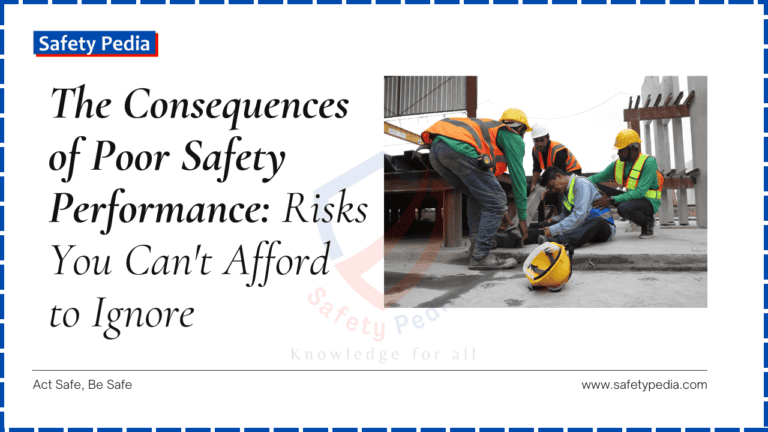
The Consequences of Poor Safety Performance: Risks You Can’t Afford to Ignore
Discover the potential consequences of poor safety performance in the workplace and how they can negatively impact both employees and the company as a whole.
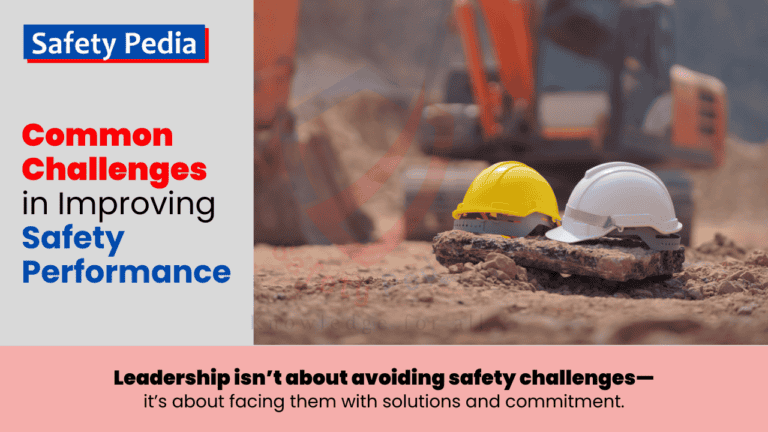
18 Common Challenges in Improving Safety Performance at Work
Discover 18 common challenges in improving safety performance at work. Learn how to overcome these obstacles for a safer workplace.
20 Best Ways to Improve Safety Performance in the Workplace
Discover the 20 best ways to improve safety performance at workplace, including actionable strategies for hazard prevention, employee engagement, safety training, and cultivating a culture of well-being.
Join Our Safety Community!
Stay informed with the latest tips and insights on occupational health, safety, and the environment.
